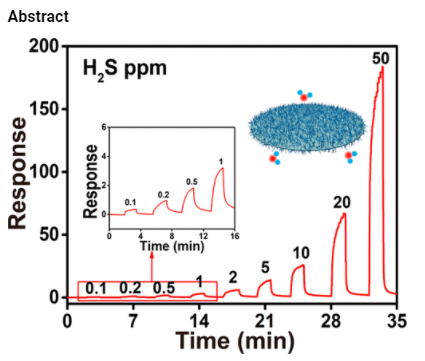文章专利

- 地址: 江苏省苏州市苏州工业园区若水路398号
- 邮箱: tzhang2009@sinano.ac.cn
- 电话: 86-512-62872706
- 传真: 0512-62603079
- 网址: http://nanosensor.sinano.ac.cn

In Situ Growth of NiO@SnO2 Hierarchical Nanostructures for High Performance H2S Sensing.ACS Appl. Mater. Interfaces 2019, 11, 44829−44836
Lin Liu, Yingyi Wang,Yanbing Dai, Guanghui Li, Shuqi Wang, Tie Li, Ting Zhang*,Sujie Qin*

ABSTRACT:
Heterostructured metal oxides with large specific surface area are crucial for constructing gas sensors with high performance. However, using slurrycoating and screen-printing methods to fabricate gas sensors cannot result in high uniformity and reproducibility of the sensors. Here, NiO nanowalls decorated by SnO2 nanoneedles (NiO@SnO2) were in situ grown on ceramic microchips via a chemical bath deposition method to detect H2S instead of print-coating and slurrycoating methods. The morphologies and compositions of the NiO@SnO2 hierarchical nanostructures (HNSs) were well tuned by varying the growth time of the NiO@SnO2 HNSs to optimize the sensing performance. The response of the NiO@SnO2 HNSs (2 h) to 1 ppm of H2S was over 23-fold higher than that of the pure NiO nanowalls and 17-fold higher than that of the pure SnO2 nanosheets. This dramatic enhancement is attributed to the large surface area of the NiO@ SnO2 HNSs and the p−n heterojunction at the heterointerface of SnO2 and NiO. The variation in the depletion layers (WSnO2 and WNiO) at the heterointerface of SnO2 and NiO greatly depends on the properties of the target gases (e.g., electron-withdrawing property (NO2) or electron-donating property (H2S)).
Full article:https://pubs.acs.org/doi/full/10.1021/acsami.9b13001
